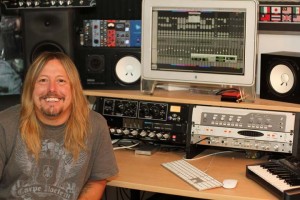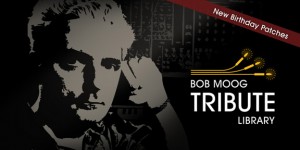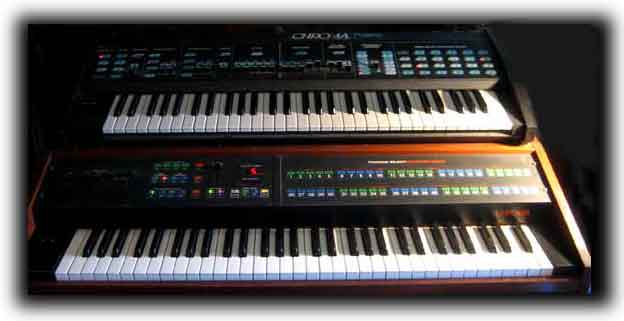Junior Sanchez Gets Dangerous
Dangerous Music 2-Bus LT and Monitor ST are key studio ingredients in renowned producer’s Electronic Dance Music projects, as well as his R&B, Rock and Pop productions
Junior Sanchez started making records when he was in high school. Now from the stage looking out over a sea of people in the dance crowd at an Ibiza island festival as a DJ – along with the Swedish House Mafia’s Steve Angello – it seems that first teenage track was quite a while ago. Sanchez has evolved from using major studios and large format consoles in New York and LA to designing and building his own high-end studio in his New York area house. To get back to the sound he had mixing on analog consoles Sanchez has chosen Dangerous Music gear for mixing and monitoring. “I have the Monitor ST, the DAC ST and the 2-Bus LT. It’s changed the whole platform of how I hear, it’s awesome,” says Sanchez. “I live my life Dangerously.”
Read More »Richie Biggs & Charlie Peacock
Producers & Engineers Working in Busy Nashville Scene get “Consistency and Killer Sound” Mixing with Dangerous 2-Bus Analog Summing
When the Civil Wars took the stage at the 2012 Grammy® Awards, Dangerous Music was part of the moment, as the band’s highly successful and great-sounding record was mixed on the Dangerous 2-Bus. The duo’s live Grammy performance was spectacular, a combination of everything musical and emotional that musicians and music fans alike appreciate. Richie Biggs and Charlie Peacock are the engineers and producers behind the sound of the Civil Wars album “Barton Hollow.” They work around the clock on multiple projects in their Nashville studio and rely on the consistent recall capability and killer sound of the Dangerous 2-Bus analog summing amp and Dangerous D-Box summing and monitor control in their hybrid Pro Tools-based mix rooms.
Read More »FOH Engineer Horace Ward

FOH engineer Horace Ward with the Dangerous Music 2-Bus summing amp (at right), mixing the Usher concert at the Moon Palace Resorts in Cancun, Mexico
Front of house engineer Horace Ward has a new secret weapon for making his live music mixes sound their best: the Dangerous Music 2-Bus. In the spirit of sharing, he’d like other engineers to know about it too, so their audiences can also get the best concert experience. The 2-Bus is best known for its role in the recording studio, bringing the tone, feel, and headroom of an analog console to digital mixes suffering from ‘in-the-box’ summing. But Ward has found a way to use the 2-Bus to get a similar enhancement – and control – over his live mixes. He says, “I don’t understand how the 2-Bus has been in the studio so long but hasn’t gotten to live shows – the sound is unbelievable.”
Read More »Lauten Audio “Atlantis” Mic
New FC-387 “Atlantis” solid-state large diaphragm condenser microphone available worldwide
Lauten Audio has begun shipping its new microphone, the FC-387 “Atlantis” model. The new mic is a solid-state large-diaphragm condenser with three distinct personalities. Atlantis features multiple switches for three different polar patterns, gain, and unique timbre settings. The FC-387 offers a blend of full and rich low- and mid-range, as well as smooth and unique high-mid and high-frequencies – recordists seeking an incredibly diverse and useful modern FET studio microphone will like it. The Atlantis FC-387 microphone retails for $1599. US and will be available worldwide from dealers June 1, 2012.
The engineer who had a huge ‘voice’ in the tuning and settings of Atlantis, Fab DuPont, a New York engineer and producer says, “Nobody is making a microphone for the modern recording process – everybody is making microphones as if we were still going through consoles and transformers to tape several times in the process of recording. The reality is we don’t. The reality is that we all record into a very clean preamp, into a very clean converter, into a very clean DAW, coming out a very clean D-to-A. And everything in incredibly open and bright and pristine; it’s really hard to make a modern, good sounding record because everything is too bright and everything is very wide open.”
Read More »Pete Evick Mixes Bret Michaels
 Engineer and Guitarist records and mixes hit records on the road for Rock & Roll Icon with Dangerous Music D-Box and Bax EQ
Engineer and Guitarist records and mixes hit records on the road for Rock & Roll Icon with Dangerous Music D-Box and Bax EQ
Pete Evick wears many musical hats. He’s the guitarist in the Bret Michaels Band, as well as Michael’s songwriting partner, (plus he has his own band: Evick); but he’s also the Bret Michaels Band engineer, and records and mixes while he’s on tour with them. Evick uses the Dangerous Music D-Box and Dangerous Bax EQ as key ingredients for his hit-record success and a killer rock sound. “The last two records we made both debuted in the top 40 Billboard charts, one at number 14, so they are legitimate hit records,” says Evick, “and they were impossible to do without the D-Box. That’s the whole point.”
Read More »‘Bob Moog Birthday’ Patches
Spectrasonics Release New Sounds for the Bob Moog Tribute Library from Sound Designer Eric Persing
 To celebrate the anniversary of Bob Moog’s 78th birthday, Spectrasonics have released 78 brand new Omnisphere patches for the Bob Moog Tribute Library! With the addition of the new ‘birthday’ patches created by Producer Eric Persing, the library now features over 800 stunning sounds for Omnisphere, the company’s flagship synthesizer.
To celebrate the anniversary of Bob Moog’s 78th birthday, Spectrasonics have released 78 brand new Omnisphere patches for the Bob Moog Tribute Library! With the addition of the new ‘birthday’ patches created by Producer Eric Persing, the library now features over 800 stunning sounds for Omnisphere, the company’s flagship synthesizer.
The new patches are a continuation of the tribute to honor the legacy of synthesizer pioneer Dr. Robert Moog and support the ongoing work of the Bob Moog Foundation. In 2011 Spectrasonics produced the Tribute library with the generosity and creative talents of many renowned synthesizer artists, and has been a huge success in benefiting the Foundation allowing them to expand their educational outreach programs. 100% of the proceeds from the “Bob Moog Tribute Library” go to benefit the Bob Moog Foundation.
Read More »CEntrance at Newport ‘T.H.E. Show’

Audiophile Desktop System: stereo pair of "MasterClass 2504" desktop 2-way coaxial speakers, the "DACmini PX"
At the 2012 T.H.E. Show in Newport Beach, CEntrance, Inc. will be showing its new Audiophile Desktop System product bundle. The system packs a stereo pair of “MasterClass 2504” desktop 2-way coaxial speakers and the “DACmini PX” desktop amplifier, headphone amp and DAC. The bundle also includes a travel case with custom foam cushioning as well as speaker and USB cables. The Audiophile Desktop System was designed from the ground up to bring Hi-Fi sound straight to the desktop for today’s Internet-connected consumers. The DAC, amp and speakers are closely matched and properly voiced to work in concert. The Audiophile Desktop System provides a complete digital audio listening solution for a street price of $2,000 USD and is available for ordering now.
“Today’s networked users, who spend their day at the desk, are forced to listen to inferior audio quality piped through standard computer speakers. That’s no fun. We pioneered the Audiophile Desktop concept to free your music from consumer-grade sound, offering mastering-level audio quality in a compact, desktop-friendly format,” states Michael Goodman, Managing Director of CEntrance. “We have tuned this system for performance and it offers better results than ad-hoc collections of components from several manufacturers. We’re confident that the new Audiophile Desktop System will turn some heads and ears.”
Read More »Billy Mohler Gets Dangerous
Artist development business takes a leap with Grammy nomination, record deals and Dangerous Music equipment
A musical life can take a few twists and turns before settling in. Early on as a musician Billy Mohler studied upright bass at both the Berklee College of Music, and the Thelonious Monk Institute of Jazz. But he’s found a niche developing artists and producing, especially solo artists and Indie bands. Mohler also plays guitar and keyboards – and drums. In fact, when he’s working with a solo artist he often plays all the instruments on the album. These days, he works in his own studio in the Los Angeles area and harnesses the power of the Dangerous Music D-Box for analog summing and monitoring. At the 2012 Grammy(r) Awards one of the recent albums Mohler has songwriting credit on was nominated for “Best Latin Pop Album,” Nuestra by Gustavo Galindo.
Mohler says, “I’ve been using the D-Box for about 3 months, and it’s incredible, I love it. I work mainly in-the-box, so it’s nice to have for bouncing out mixes or songwriting sessions. Everything sounds wider, a little more transparent, more punch. It kind of bridges the gap for me,” he explains. “You can drive it hard so you can give it a nice analog crunch. It adds that next level of glue that I wasn’t getting from my in-the-box mixes. Mixes have a clear separation between the instruments and being able to sum the bass on it’s own output, I notice a smooth consistent bass response that I wasn’t getting from my in-the-box mixes. There’s just more definition in each instrument, more character and punch.”
Read More »Back in the Day: Silicon Valley & Music
As told to Linda Jacobson (lindaj@well.com)
LJ: Paul, what were you doing in 1984 — the year before you became a founding staff member of Opcode Systems? How would you describe the “work lifestyle,” routine, and group dynamic behind-the-scenes in your world then? Was the SF Bay Area audio industry back then influenced more by the cultures of the computer industry and Silicon Valley, music industry, San Francisco scene, and/or film industry and Hollywood?
PdB: In 1982 I had purchased a Rhodes Chroma synth and in 1983 created one of the first computer-based electronic music “home” studios in the San Francisco Bay Area around that instrument. I had added the Apple II computer and the sequencing and editing software from Fender along with the SIMPLE System synchronizer for video and audio and the requisite mixers, mics, speakers, 2-channel and multitrack tape decks. I was composing music for film and television and through my friend Doug McKechnie’s connection at Lucas Film I even had a chance to write a demo cue for the final Ewok scene in the latest Star Wars: Return of the Jedi movie, apparently Lucas wanted to hear some other ideas than what John Williams had come up with. Three of us in the San Francisco Synthesizer Ensemble got to write a sketch for the cue. It was exciting to see part of the movie before it came out.

The Rhodes Chroma and Chroma Polaris
Dangerous Music Rocks The Grammys
 Dangerous Music is extending congratulations to several of their users who have Grammy(r) nominated projects for 2011. All the clients have great praise for the Dangerous Music gear they used in their productions, from the Foo Fighters, with mastering engineers Emily Lazar and Joe LaPorta, the Kings of Leon with co-producer and engineer Jacquire King, Glenn Schick mastering for Canton Jones, and Nashville’s producer and engineer John Schirmer for Keb Mo, to the engineers and producers at New York’s Stadium Red studios who turned out a host of nominations for projects from artists J. Cole, Chris Brown, Marsha Ambrosius, and classical composer Steven Mackey.
Dangerous Music is extending congratulations to several of their users who have Grammy(r) nominated projects for 2011. All the clients have great praise for the Dangerous Music gear they used in their productions, from the Foo Fighters, with mastering engineers Emily Lazar and Joe LaPorta, the Kings of Leon with co-producer and engineer Jacquire King, Glenn Schick mastering for Canton Jones, and Nashville’s producer and engineer John Schirmer for Keb Mo, to the engineers and producers at New York’s Stadium Red studios who turned out a host of nominations for projects from artists J. Cole, Chris Brown, Marsha Ambrosius, and classical composer Steven Mackey.
Rock royalty Foo Fighters and platinum favorites Kings of Leon share Rock Grammy accolades with Best Rock Album nominations, while the album and songs from the Foo Fighters “Wasted Light” also have nominations for Album of the Year, Best Rock Performance, Best Hard Rock/Metal Performance, Best Rock Song and Best Long Form Music Video. The Foo Fighters album, (produced by Butch Vig who’s up for Producer Of The Year, Non-Classical), was mastered by Emily Lazar and Joe LaPorta at The Lodge Mastering in NY, using Dangerous Music equipment. While the Kings of Leon release “Come Around Sundown” was co-produced and mixed by Jacquire King using Dangerous Music gear extensively throughout the production process.
Read More »



